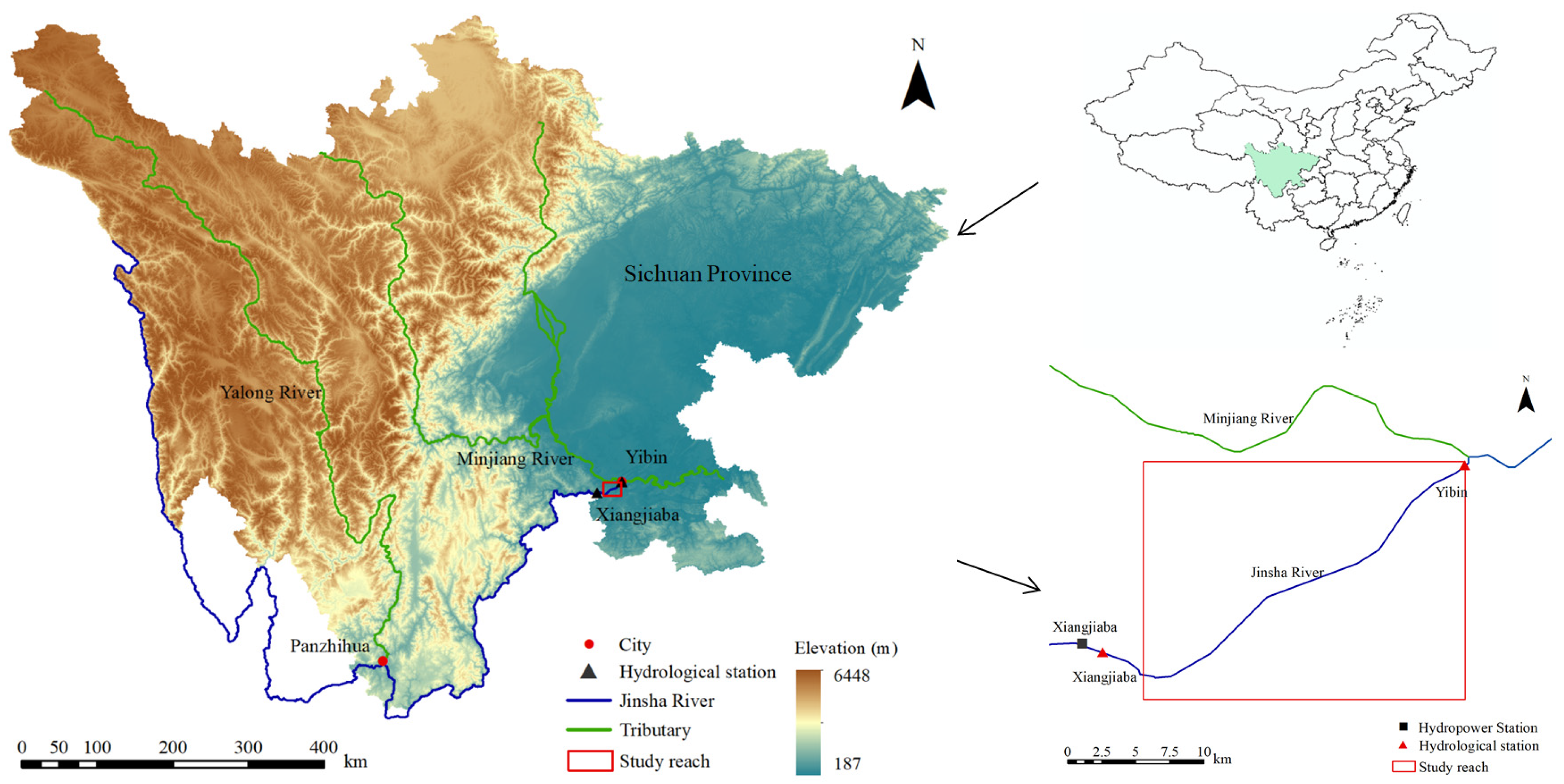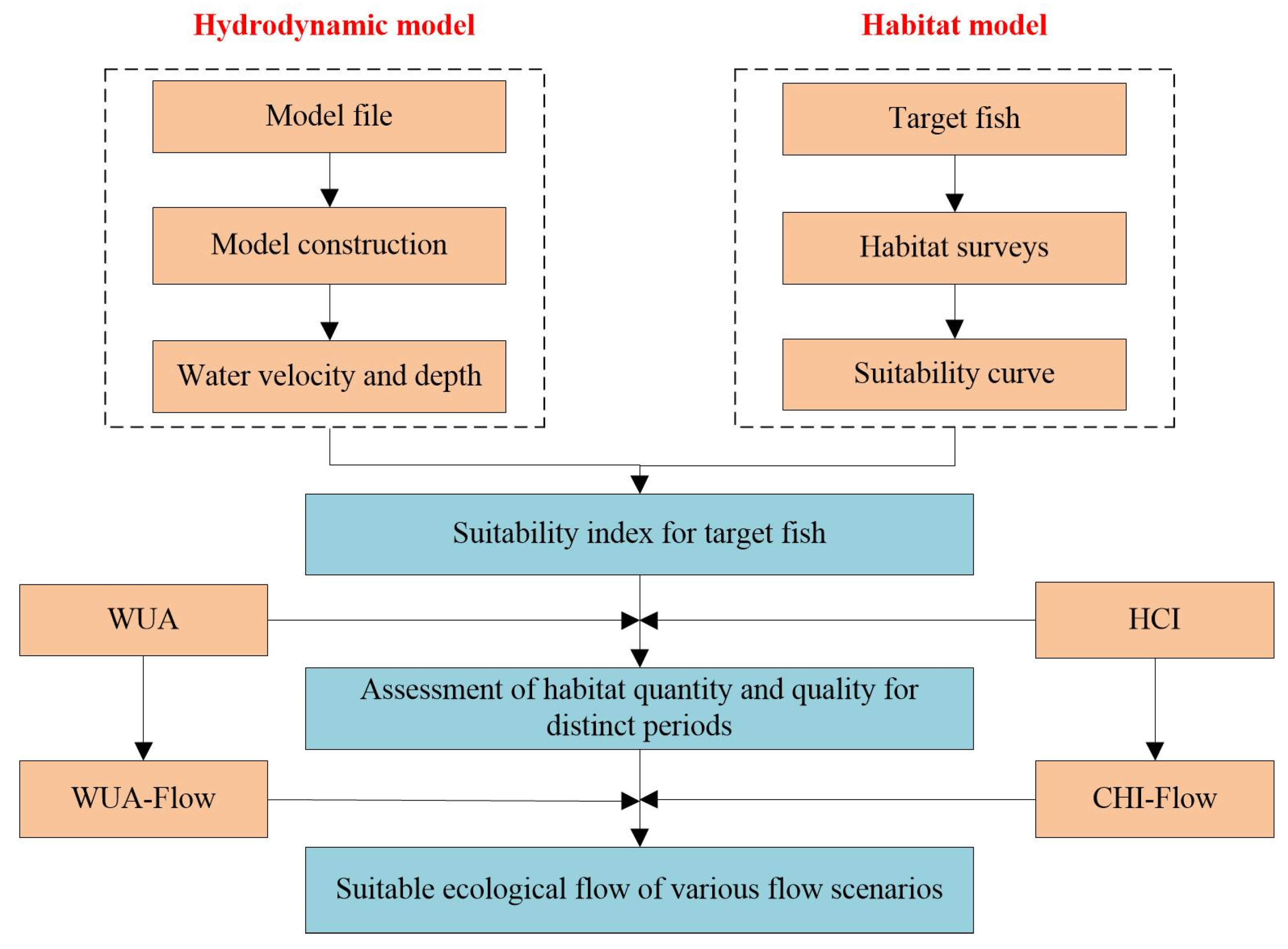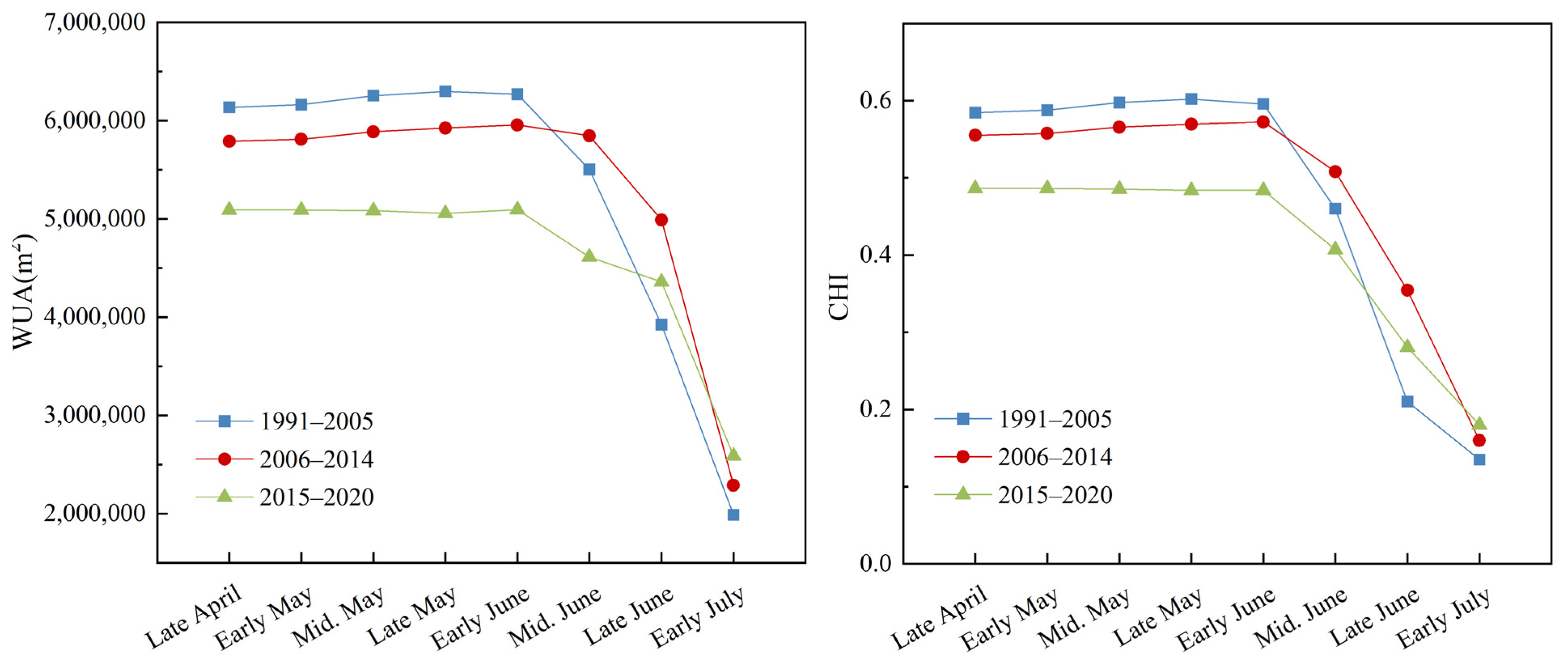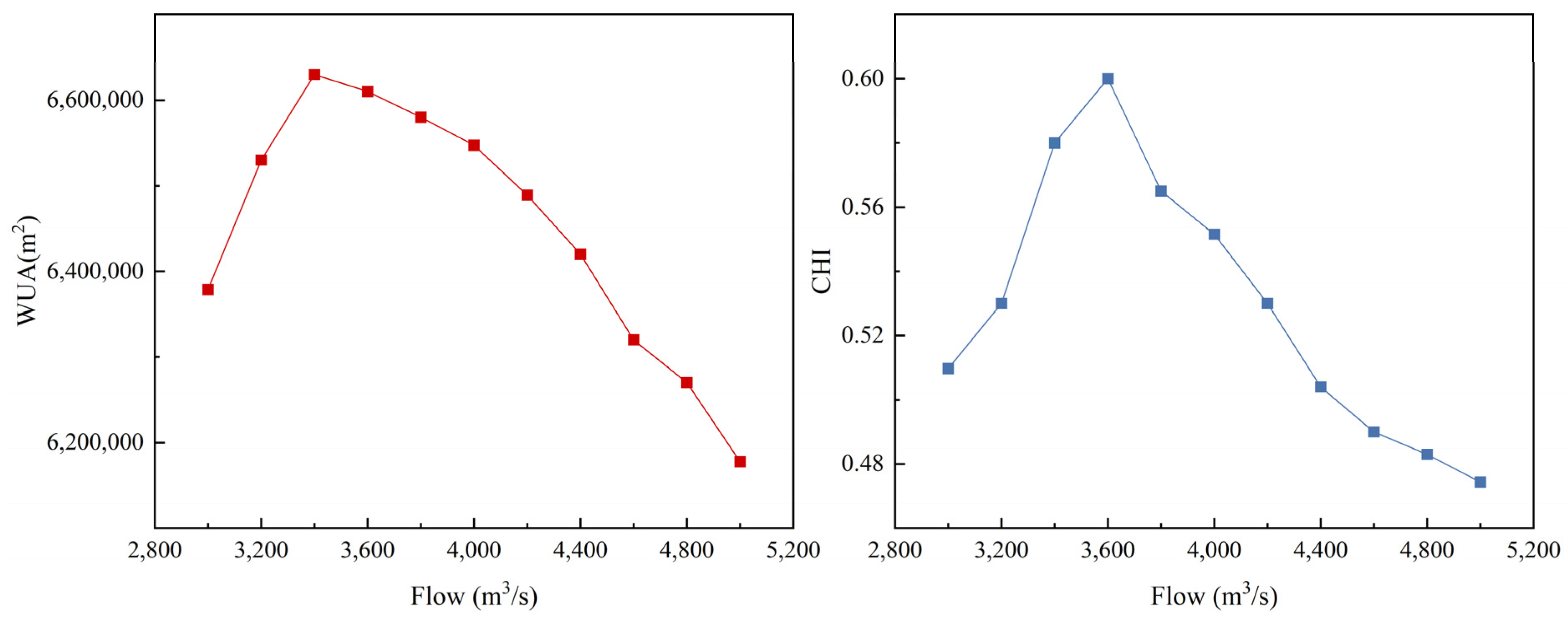Assessment of Fish Habitats and Suitable Ecological Flow under Hydropower Operation
Abstract
1. Introduction
2. Materials and Methods
2.1. Study Area and Data Sources
2.2. Methods
2.2.1. Hydrodynamic Model
2.2.2. Habitat Model
2.2.3. Target Fish and the Suitability Curves
2.2.4. Assessment of Fish Habitat and Suitable Ecological Flow
3. Results
3.1. Assessment of Habitat Quantity and Quality
3.1.1. Runoff Pattern
3.1.2. Assessment of Habitat
3.2. Assessment of Suitable Ecological Flow
4. Discussion
4.1. Impacts of Habitat Changes on Fish after Hydropower Operation
4.2. Comprehensive Analysis of the Suitable Ecological Flow and Habitat Assessment Approach
5. Conclusions
- (1)
- In this study, Coreius guichenoti was selected as the target fish. The accuracy of Mike21 meets the required standards, allowing for precise simulations of the hydrodynamic characteristics of Coreius guichenoti habitats under varying flow conditions. A habitat model for Coreius guichenoti was established based on the relevant literature. The optimal depth for the fish ranges 1.2–11.5 m, and the optimal flow velocity ranges 0.3–1.3 m/s during the spawning period.
- (2)
- The spawning phase of Coreius guichenoti was divided into eight phases, and the habitat conditions for the eight phases during different periods were assessed. The results indicate that the average WUA and HCI during the construction period are close to those of the natural period. In comparison to the natural period, the average WUA during the operation period decreased by 9.2%, and the average HCI decreased by 0.05 [38]. However, with an increase in flow, in late June and early July, both the construction and operation periods exhibit higher WUA and HCI compared to the natural period.
- (3)
- Based on the historical flow records from the Xiangjiaba Hydrological Station, a range of 13 flow scenarios was established, spanning from 1000 to 13,000 m3/s with intervals of 1000 m3/s. Utilizing the curves depicting the relationships between WUA, HCI, and flow, it was identified that the simulated habitat conditions are optimal when the flow is between 3000 and 5000 m3/s. Further refining the flow scenarios led to the determination of the suitable ecological flow as 3500 m3/s.
Author Contributions
Funding
Data Availability Statement
Acknowledgments
Conflicts of Interest
References
- Peng, F.; Li, K.; Liang, R.; Yang, S.; Wei, Q.; Zhao, G. Positive effect of a canal system and reservoir group on the spatial-temporal redistribution of water resources in a pinnate drainage pattern. Sci. Total Environ. 2020, 744, 140855. [Google Scholar] [CrossRef]
- Wu, Y.; Guo, L.; Xia, Z.; Jing, P.; Chunyu, X. Reviewing the Poyang Lake Hydraulic Project Based on Humans’ Changing Cognition of Water Conservancy Projects. Sustainability 2019, 11, 2605. [Google Scholar] [CrossRef]
- Smith, J.M.; Mather, M.E. Beaver dams maintain fish biodiversity by increasing habitat heterogeneity throughout a low-gradient stream network. Freshw. Biol. 2013, 58, 1523–1538. [Google Scholar] [CrossRef]
- Guo, C.; Chen, Y.; Gozlan, R.E.; Li, Z.; Mehner, T.; Lek, S.; Paukert, C.P. Biogeographic freshwater fish pattern legacy revealed despite rapid socio-economic changes in China. Fish Fish. 2019, 20, 857–869. [Google Scholar] [CrossRef]
- Yao, W.; An, R.; Yu, G.; Li, J.; Ma, X. Identifying fish ecological risk patterns based on the effects of long-term dam operation schemes. Ecol. Eng. 2021, 159, 106102. [Google Scholar] [CrossRef]
- Yang, G.; Bao, M.; Cong, N.; Kattel, G.; Li, Y.; Xi, Y.; Wang, Y.; Wang, Q.; Yao, W. Application of a fish habitat model to assess habitat fragmentation using high flow and sediment transport in the Rumei Dam in Lancang River (China). Ecohydrology 2023, e2583. [Google Scholar] [CrossRef]
- Yao, W. Stocking to offset negative effects of dam construction and balance the ecosystem. Fish. Manag. Ecol. 2023, 30, 627–647. [Google Scholar] [CrossRef]
- Guan, X.; Zhang, Y.; Meng, Y.; Liu, Y.; Yan, D. Study on the theories and methods of ecological flow guarantee rate index under different time scales. Sci. Total Environ. 2021, 771, 145378. [Google Scholar] [CrossRef] [PubMed]
- Meng, Y.; Xu, W.; Guan, X.; Guo, M.; Wang, X.; Yan, D. Ecology-habitat-flow modular simulation model for the recommendation of river ecological flow combination. Environ. Model. Softw. 2023, 169, 105823. [Google Scholar] [CrossRef]
- Jacobson, P.C.; Cross, T.K.; Dustin, D.L.; Duval, M. A Fish Habitat Conservation Framework for Minnesota Lakes. Fisheries 2016, 41, 302–317. [Google Scholar] [CrossRef]
- Spurgeon, J.; Pegg, M.; Parasiewicz, P.; Rogers, J. River-Wide Habitat Availability for Fish Habitat Guilds: Implications for In-Stream Flow Protection. Water 2019, 11, 1132. [Google Scholar] [CrossRef]
- Dey, C.J.; Rego, A.I.; Bradford, M.J.; Clarke, K.D.; McKercher, K.; Mochnacz, N.J.; de Paiva, A.; Ponader, K.; Robichaud, L.; Winegardner, A.K.; et al. Research priorities for the management of freshwater fish habitat in Canada. Can. J. Fish. Aquat. Sci. 2021, 78, 1744–1754. [Google Scholar] [CrossRef]
- Mao, X. Review of fishway research in China. Ecol. Eng. 2018, 115, 91–95. [Google Scholar] [CrossRef]
- Yang, X.; Zhang, S.; Wu, C.; Zhang, R.; Zhou, Y. Ecological and navigational impact of the construction and operation of the Qingyuan dam. Ecol. Indic. 2023, 154, 110563. [Google Scholar] [CrossRef]
- Quan, Q.; Gao, S.; Shang, Y.; Wang, B. Assessment of the sustainability of Gymnocypris eckloni habitat under river damming in the source region of the Yellow River. Sci. Total Environ. 2021, 778, 146312. [Google Scholar] [CrossRef] [PubMed]
- Wang, P.; Shen, Y.; Wang, C.; Hou, J.; Qian, J.; Yu, Y.; Kong, N. An improved habitat model to evaluate the impact of water conservancy projects on Chinese sturgeon (Acipenser sinensis) spawning sites in the Yangtze River, China. Ecol. Eng. 2017, 104, 165–176. [Google Scholar] [CrossRef]
- Liu, S.; Luo, W.; Ge, L.; Wang, Y. An evaluation method for the priority protection of fishes based on multiple ecological dimensions. J. Freshw. Ecol. 2023, 38, 2144956. [Google Scholar] [CrossRef]
- Yang, S.; Zhang, Z.; Wang, Y.; Liang, R.; Wan, Y.; Li, K. An improved 3D fish habitat assessment model based on the graph theory algorithm. Ecol. Indic. 2023, 148, 110022. [Google Scholar] [CrossRef]
- Valavanis, V.D.; Pierce, G.J.; Zuur, A.F.; Palialexis, A.; Saveliev, A.; Katara, I.; Wang, J. Modelling of essential fish habitat based on remote sensing, spatial analysis and GIS. Hydrobiologia 2008, 612, 5–20. [Google Scholar] [CrossRef]
- Baranya, S.; Fleit, G.; Jozsa, J.; Szaloky, Z.; Toth, B.; Czegledi, I.; Eros, T. Habitat mapping of riverine fish by means of hydromorphological tools. Ecohydrology 2018, 11, e2009. [Google Scholar] [CrossRef]
- Petesse, M.L.; Petrere, M., Jr. Tendency towards homogenization in fish assemblages in the cascade reservoir system of the Tiete river basin, Brazil. Ecol. Eng. 2012, 48, 109–116. [Google Scholar] [CrossRef]
- Poff, N.L.; Matthews, J.H. Environmental flows in the Anthropocence: Past progress and future prospects. Curr. Opin. Environ. Sustain. 2013, 5, 667–675. [Google Scholar] [CrossRef]
- Fu, Y.; Leng, J.; Zhao, J.; Na, Y.; Zou, Y.; Yu, B.; Fu, G.; Wu, W. Quantitative calculation and optimized applications of ecological flow based on nature-based solutions. J. Hydrol. 2021, 598, 126216. [Google Scholar] [CrossRef]
- Liu, C.; Men, B. An ecological hydraulic radius approach to estimate the instream ecological water requirement. Prog. Nat. Sci.-Mater. Int. 2007, 17, 320–327. [Google Scholar]
- Wang, H.; Wang, H.; Hao, Z.; Wang, X.; Liu, M.; Wang, Y. Multi-Objective Assessment of the Ecological Flow Requirement in the Upper Yangtze National Nature Reserve in China Using PHABSIM. Water 2018, 10, 326. [Google Scholar] [CrossRef]
- Tharme, R.E. A global perspective on environmental flow assessment: Emerging trends in the development and application of environmental flow methodologies for rivers. River Res. Appl. 2003, 19, 397–441. [Google Scholar] [CrossRef]
- Hu, W.; Gu, W.; Miao, D.; Shao, D. Research on the Ecological Flow and Water Replenishment Thresholds for Diversion Rivers Based on the MC-LOR Algorithm. Water Resour. Manag. 2022, 36, 5353–5369. [Google Scholar] [CrossRef]
- Mao, Y.; Huang, J.; Li, R.; Huang, W.; Wang, Q.; Feng, J. Optimal reservoir operation based on hydrological and hydraulic methods incorporating the multiple water replenishment process. J. Clean. Prod. 2020, 276, 124154. [Google Scholar] [CrossRef]
- Kumar, A.U.; Jayakumar, K.V. Modelling of environmental flow requirements using hydraulic and habitation models. Ecol. Indic. 2021, 121, 107046. [Google Scholar] [CrossRef]
- Hough, I.M.; Warren, P.H.; Shucksmith, J.D. Designing an environmental flow framework for impounded river systems through modelling of invertebrate habitat quality. Ecol. Indic. 2019, 106, 105445. [Google Scholar] [CrossRef]
- Nagaya, T.; Shiraishi, Y.; Onitsuka, K.; Higashino, M.; Takami, T.; Otsuka, N.; Akiyama, J.; Ozeki, H. Evaluation of suitable hydraulic conditions for spawning of ayu with horizontal 2D numerical simulation and PHABSIM. Ecol. Model. 2008, 215, 133–143. [Google Scholar] [CrossRef]
- Johnson, J.A.; Sivakumar, K.; Rosenfeld, J. Ecological flow requirement for fishes of Godavari river: Flow estimation using the PHABSIM method. Curr. Sci. 2017, 113, 2187–2193. [Google Scholar] [CrossRef]
- Liu, Q.; Zhang, P.; Cheng, B.; Li, Y.; Li, J.; Zhou, H.; Sun, G.; Qing, J.; Zhu, Z.; Lu, Y.; et al. Incorporating the life stages of fish into habitat assessment frameworks: A case study in the Baihetan Reservoir. J. Environ. Manag. 2021, 299, 113663. [Google Scholar] [CrossRef]
- Yang, Z.; Zhang, P.; Tang, H.; Gong, Y.; Dong, C.; Chen, X.; Zhao, N. The formation of habitat suitability curves for Coreius guichenoti (Sauvage & Dabry de Thiersant, 1874) of the lower Jinsha River. Ecol. Sci. 2017, 36, 129–137. [Google Scholar]
- Zhang, P.; Qiao, Y.; Schineider, M.; Chang, J.; Mutzner, R.; Fluixa-Sanmartin, J.; Yang, Z.; Fu, R.; Chen, X.; Cai, L.; et al. Using a hierarchical model framework to assess climate change and hydropower operation impacts on the habitat of an imperiled fish in the Jinsha River, China. Sci. Total Environ. 2019, 646, 1624–1638. [Google Scholar] [CrossRef]
- Vilizzi, L.; Copp, G.H.; Roussel, J.M. Assessing variation in suitability curves and electivity profiles in temporal studies of fish habitat use. River Res. Appl. 2004, 20, 605–618. [Google Scholar] [CrossRef]
- Stefunkova, Z.; Macura, V.; Skrinar, A.; Majorosova, M.; Dolakova, G.; Halaj, P.; Petrova, T. Evaluation of the Methodology to Assess the Influence of Hydraulic Characteristics on Habitat Quality. Water 2020, 12, 1131. [Google Scholar] [CrossRef]
- Zhang, P.; Li, K.-F.; Wu, Y.-L.; Liu, Q.-Y.; Zhao, P.-X.; Li, Y. Analysis and restoration of an ecological flow regime during the Coreius guichenoti spawning period. Ecol. Eng. 2018, 123, 74–85. [Google Scholar] [CrossRef]









Disclaimer/Publisher’s Note: The statements, opinions and data contained in all publications are solely those of the individual author(s) and contributor(s) and not of MDPI and/or the editor(s). MDPI and/or the editor(s) disclaim responsibility for any injury to people or property resulting from any ideas, methods, instructions or products referred to in the content. |
© 2024 by the authors. Licensee MDPI, Basel, Switzerland. This article is an open access article distributed under the terms and conditions of the Creative Commons Attribution (CC BY) license (https://creativecommons.org/licenses/by/4.0/).
Share and Cite
Yan, S.; Qin, T.; Zhang, X.; Hou, L. Assessment of Fish Habitats and Suitable Ecological Flow under Hydropower Operation. Water 2024, 16, 569. https://doi.org/10.3390/w16040569
Yan S, Qin T, Zhang X, Hou L. Assessment of Fish Habitats and Suitable Ecological Flow under Hydropower Operation. Water. 2024; 16(4):569. https://doi.org/10.3390/w16040569
Chicago/Turabian StyleYan, Sheng, Tianling Qin, Xiangyang Zhang, and Lei Hou. 2024. "Assessment of Fish Habitats and Suitable Ecological Flow under Hydropower Operation" Water 16, no. 4: 569. https://doi.org/10.3390/w16040569
APA StyleYan, S., Qin, T., Zhang, X., & Hou, L. (2024). Assessment of Fish Habitats and Suitable Ecological Flow under Hydropower Operation. Water, 16(4), 569. https://doi.org/10.3390/w16040569






